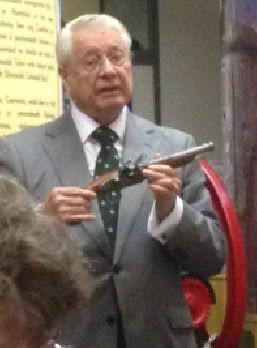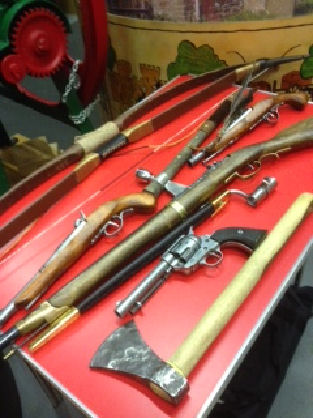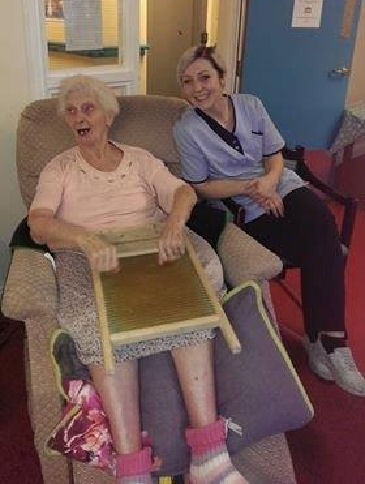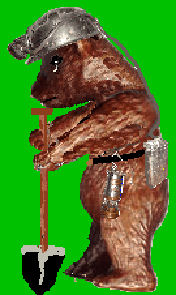Dates for your Diary
Ongoing – WW1 Exhibition in the Museum
Saturday 10th March – Coffee Morning – a talk on the History of St David. – please note change of date due to adverse weather conditions.
Saturday 14th April – Coffee Morning – ‘Navy Day’ – all things nautical!
Monday 16th April 1pm – Annual luncheon, this year at Llanhilleth Institute – don’t forget to book your place! Cost £20 for two courses plus tea/coffee. Guest speaker Mr Jack Hanbury.
February 100 Club
No. 13 Alison Staples £20
No. 97 Jen Price £10
It is with regret that we have had to remove the third (£5) prize from the 100 Club. This is due to falling numbers of participants, however the first and second prizes will remain at £20 and £10 respectively for the time being at least.
Coffee Morning ‘Handle with Care’
 Our recent coffee morning was a great success and raised a much needed £88 towards the museum’s considerable annual running costs. We are extremely grateful to Mr Simon Campbell who donated the replica weapons which comprised everything from medieval daggers and swords to bows, pistols and even a tomahawk. Mr Campbell also gave a very interesting talk on the weapons during which we learnt the origins of such phrases as ‘a flash in the pan’, ‘burying the hatchet’ and
Our recent coffee morning was a great success and raised a much needed £88 towards the museum’s considerable annual running costs. We are extremely grateful to Mr Simon Campbell who donated the replica weapons which comprised everything from medieval daggers and swords to bows, pistols and even a tomahawk. Mr Campbell also gave a very interesting talk on the weapons during which we learnt the origins of such phrases as ‘a flash in the pan’, ‘burying the hatchet’ and  ‘lock, stock and barrel’ – phrases we all use without really thinking about where they came from!
‘lock, stock and barrel’ – phrases we all use without really thinking about where they came from!
Our next coffee mornings will be on 10th March (new date due to adverse weather conditions on 3rd) & 14th April. Please do come along as we rely on the funding raised from events such as these to keep the museum open and if you have anything we could use for raffle prizes, they would be gratefully received!
A Visit to Penybont Care Home
The museum was asked to take some items from the museum to Penybont Care Home in Blaenau Gwent. Jen Price and I, volunteered to go. We were shown into the day room where eight men and women were waiting for us.
 We first took out the washing items. All the items were recognised by the elderly residents but needed to be explained to the young carers who had never seen a dolly or wash board. It was remembered how hard washday had been...boiling the water, washing sheets etc with the dolly, the drying of clothes and often washing had been taken in to earn extra money but with the help of a blue bag how beautifully clean and white the sheets etc had been. Bath night was remembered in front of the fire in the large metal tub...children first before Dad and Mum. Dad would wash when he came off shift in the pit, black from the coal dust!
We first took out the washing items. All the items were recognised by the elderly residents but needed to be explained to the young carers who had never seen a dolly or wash board. It was remembered how hard washday had been...boiling the water, washing sheets etc with the dolly, the drying of clothes and often washing had been taken in to earn extra money but with the help of a blue bag how beautifully clean and white the sheets etc had been. Bath night was remembered in front of the fire in the large metal tub...children first before Dad and Mum. Dad would wash when he came off shift in the pit, black from the coal dust!
Next the baking items...the rolling pin, bakestone and metal mincer. It was remembered how welsh cakes were made. Some liked currants others not. One lady remembered making 100 to take to relatives in London but when they got there the father put the tin on the top shelf and only he ate them. Again the young carers did not know what the mincer was or how it was put on the edge of the table to make mince with what was left of the Sunday joint.
We had bedtime items. The pot hot water bottle brought back memories of how cold it had been. Coats were put on the beds over the blankets and all the children slept in one bed to keep warm. The candle and candlestick brought memories of poor lighting and large frightening shadows on the wall. The dangers were remembered. One lady remembered losing her long ringlets to the fire. She had been reading by candle light and leaned too close to the candle and her ringlets caught fire. It was quickly put out but she had short hair for a long time!
The potties led to laughter and tales of outside toilets. One old man told us he had been a 'rag and bone’ man. Taking his horse and cart around the area collecting metal objects such as those we had taken... the shoelast, the irons and the bakestones …putting a value on them all. He had trained to be a miner but the life underground wasn’t for him.
We had some prints of photos from the area. The one of Crumlin Viaduct brought memories of travelling by train, going over the viaduct and how small the houses and people below appeared. The train had been used to go to Hereford in the summer, fruit and hop picking. One lady remembered taking the train with her mum and her twelve brothers and sisters with great excitement as it was their summer holiday. They went every year. They would be met at the station by the farmer in his tractor and trailer and taken to the huts which would be their home for the summer. Everyone worked hard collecting the hops or apples, even the youngest children but it was the best of times. Mum was in trouble when they got home though as she was reported for taking the children out of school!
We took games they recognised... marbles, ‘ball in the cup’, pop guns. I took out a yo-yo and the rag and bone man told how he had given these to the children for a bag of rags. Then he told us how he asked the mothers if they needed any “balloons” to stop the babies! One lady remembered how she had found one of these out in the back lane and, thinking it was a balloon that hadn’t burst, she blew it up and ran in to show her mum. Mum realised what it was, grabbed it off her, threw it in the fire and said ‘oh no you must never put it in your mouth - I ‘ll have to wash your mouth out with disinfectant now’. Mum scrubbed so hard her lips and mouth were sore and to this day, whenever she smells disinfectant she thinks of this!
One of the favourite things with the ladies was trying on and modelling the hats we had taken in. I think the residents appreciated our visit. It certainly made Jen and l giggle and we have been asked back!
Judith Williams
Have you renewed your membership yet?
It’s still just £6 a year or £25 a year to be a Vice President. We need your support so please renew your membership if you haven’t already done so and if you could spread the word to encourage friends or family to become members it would be much appreciated.
Guernsey
Guernsey is a tiny island just 12 miles wide and 24 square miles in total which makes it about half the size of Jersey. Having never been to any of the Channel Islands, in October 2017 my husband and I decided it was time we went and so we booked a four night, Monday to Friday, last minute short break.
It was not one of our more successful trips! My first mistake was booking to travel by ferry (taking our car with us) rather than flying. My second was to book to travel on the 30th anniversary of the hurricane that hit Britain in 1987…! Because, as if to commemorate the 30 year anniversary, hurricane Ophelia chose to put in an appearance thereby rendering travel by ferry a non-starter! We had travelled to Poole on the Sunday before our ferry trip as we had an early sailing, so instead of getting on the ferry, we spent Monday exploring nearby Weymouth while observing an eerily red sun caused by Sahara dust apparently dragged in by Ophelia. We finally arrived in Guernsey a day late.
The first thing that struck me about Guernsey was how ‘English’ it was though I noticed all the post boxes were blue not red (a local told me they like to be a bit different). If I had to describe Guernsey in one word though it would be, without hesitation, ‘claustrophobic’. I had no idea that most of its roads are no more than single track lanes and so we decided to abandon our plan to explore the island by car and use the buses instead, and so the next morning we hopped on the number 81 to St Peters Port, the capital.
 Using the buses was an experience in itself, taking up the width of the whole road, the locals think nothing of popping onto a private driveway to dive out of the way of the oncoming bus. I noticed that, while most houses had driveways, none had drive gates, so I guess this is to allow their drives to be used as passing points!
Using the buses was an experience in itself, taking up the width of the whole road, the locals think nothing of popping onto a private driveway to dive out of the way of the oncoming bus. I noticed that, while most houses had driveways, none had drive gates, so I guess this is to allow their drives to be used as passing points!
We explored, St Peters Port, a very quaint town with narrow cobbled streets not unlike ‘The Shambles’ in York, and we also visited La Valette Underground Military Museum. which is just one of many museums in St Peters Port.
Guernsey, like all the Channel Islands, was occupied by the Nazis during the second world war and this museum actually occupies the tunnels built by the Germans for U-boat fuel storage. The memorabilia displayed here tells the story of the suffering of the islanders during the occupation. My husband would have loved to bring many of the things there home for our museum!
The following day we planned to visit five more museums, The Maritime Museum, The Royal Guernsey Militia Museum, 201 Squadron Museum, The Royal Guernsey Light Infantry Museum and The Story of Castle Cornet Museum. However, you know what they say about the best laid plans…!
That evening there was another weather warning, Storm Brian was heading our way! I checked the ferry website and was alarmed to see they were advising those who needed to get home for the weekend to transfer to the Thursday crossing as travel on Friday (our pre-booked travel day) was in doubt as was Saturday and possibly even Sunday. This meant we either had to bring our return ferry forward a day, or take a chance and stay but might get stranded there over the weekend. For me it was no-brainer as they say, and so after just two nights and one full day on the island we had to return home.
If you like museums and you like history then Guernsey has an abundance of both but learn from my mistake and don’t visit by ferry in the storm season! Ironically, while the Saturday sailing was cancelled, the ferry did sail Friday after all, albeit the sailing time was brought forward, so we could have stayed, oh to have a crystal ball!
Sally Murphy
In response to the story about my cat Bonnie last month, I received from Mr Simon Campbell (see page one), this delightful photo of his cat Spartacus, doing what cats do best - making a nuisance of themselves!
Arriva Trains Wales apologise for the delay - this is due to an animal on the line….

If you enjoyed Kath’s article on postcards last month, check out the link on the museum’s Facebook page for some old photos of Abertillery.
Museum Matters
Women’s equality has a long history. A woman from Abertillery little known was among the forefront of this fight!
Beatrice Green (nee Dykes) was born in 1895 in the bustling coalfield town of Abertillery in Monmouthshire, South Wales. She was one of three daughters to William Dykes and Mary Ann Dykes. William Dykes switched from iron puddling to coal mining after the closure of the iron works. The family lived at various times in Ashfield Road, Gladstone Street and Cwm Street in Abertillery. Beatrice, the youngest, was educated locally in Abertillery, firstly at the Central School and then later at Abertillery County School.
The children were taken as babies to the nearby Ebenezer Baptist Chapel and so began a long and close affiliation with Christianity. Beatrice was baptized at the age of seventeen and from then as a young adult continued to immerse herself in church matters. She established herself, through her work in the church, as an effective communicator and organizer becoming involved in the work of the Sunday School and the Girls Own Club. The years spent teaching the Sunday school's intermediate level became a useful tool during her short teaching career. Before her marriage in the summer of 1916 to Ron Green, a local miner, she taught in various council schools in the area but was forced to give up a profession that she loved as women teachers were prohibited to continue work on marriage. Beatrice took an active interest in the Abertillery & District Hospital that was built, funded by public subscription, in 1922. She worked tirelessly as the secretary of the hospital's Linen League from its inauguration on 30 August 1922. The League was made up of a group of local women, including both of Beatrice's sisters and a number of Labour Party women, who worked to supply the hospital's linen and washing services. They organised fund-raising events in order to purchase materials and used their own sewing skills to make items like sheets and pillow cases. The League was also consulted on developments in the hospital such as David Daggar's proposal for a birth control clinic to be introduced in the hospital in 1925. Beatrice was closely involved with much of the hospital's decision-making. During the twenties she became a close friend of Marie Stopes who was a fundamental figure in the clinic's formation. Beatrice herself was a supporter of the clinic, although the League, like the local women's section, did not unanimously back its introduction to the hospital. The clinic lasted for 16 months before it was forced to close due to intense opposition led by the local clergy.
Throughout the 1920s Beatrice Green established herself as a as a prominent member of the local Labour Party. In 1920, the
Abertillery Women's Section elected Green as a delegate to attend the first conference of the Monmouthshire Labour Women's Advisory Council.
November 1927 with the miners wages low, the Committee ensured that sick and invalid children were cared for and set up sewing committees so that all children in their respective localities were adequately clothed. Adoption schemes were arranged which involved sending children of the mining districts to stay with women in and around London. They sought out any pregnant women in the area and ensured that they received extra food and expectant mothers made as comfortable as possible. Ten shillings were allocated to each mother, to purchase the necessities before the birth of a child, and 30 shillings once the child had been born. She was one of three miners' wives from south Wales who, in an attempt to increase support for the miners and raise funds for the Committee, travelled to London and other unaffected areas of Britain. Green's ability to adapt to and cope with new situations, together with her organisational and public speaking skills, made her an obvious candidate for the delegation of miners and miners' wives that visited Russia in 1926. Her trip included visits to the salt mines at Liebrecht, the coalmines of the Donetz Basin and the oil fields of Grozny. In all three she found evidence of the constructive policy in operation and real attempts being made to change the old conditions and raise the workers' standard of life. Of the coal mines, she wrote, these were of special interest to us because she marveled at women's acquisition of equal political, moral and social rights with men, and noted that, in addition, working women were assisted in the workplace by paid maternity leave and crèche facilities.
Her obituary reads; Beatrice Green herself was certainly a woman of action and was so right up until her untimely death, aged 32, on 19 October 1927. She was not someone who was prepared to sit back and allow the injustices of the system to go unchallenged. If she was involved in an organisation, she immersed herself completely in its work. If she was in a movement she put all her energy and might into it. The ambulance “Beatrice” that the people of Abertillery named after her was a fitting tribute.
Although her political career had spanned a relatively short period she had, by the time of her death, an impressive political track record. Potentially Beatrice Green had a promising future ahead of her in The Labour movement. She possessed all of the qualities required to become an excellent leader that would have, in all probability, ensured her a place  in Parliament.
in Parliament.
A fuller Version of her life is available from Don Bearcroft Curator.
Top Of Page
